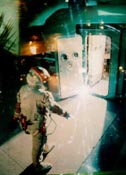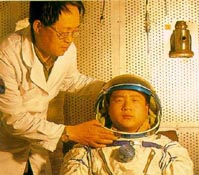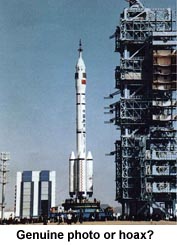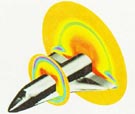A Chinese Man on the Moon? That's No Flight of Fancy
By Douglas C. McGill
 (Virtual China News, Oct. 21) Will China be the third nation in human history to put a man into space? Will it be the second nation to land an unmanned lunar module? Will it put the next man on the moon?
(Virtual China News, Oct. 21) Will China be the third nation in human history to put a man into space? Will it be the second nation to land an unmanned lunar module? Will it put the next man on the moon?
"Almost certainly," "very possibly," and "just maybe" are the answers to those questions, respectively, say space and aeronautics experts who have followed the many recent twists and turns of China's manned space program.
This may surprise people who when asked to think of technology in China may still conjure images of Soviet-style tractors, truck-mounted missiles and lumbering tanks - such as those seen proudly on parade during the PRC's 50th anniversary bash on Oct. 1.
In fact, manned space flight may be one area where China is close to catching up with the West, although it's understandable why this fact isn't widely known. With a manned space program being so potent and fragile a symbol of national pride, and because it is run by the military in China, the nation's leaders are reluctant to speak about it much.
Military Satellites
Yet in recent months, a steady flow of clues has emerged from China revealing what appears to be the country's renewed determination, more than 20 years after the idea was first seriously raised in Beijing, to put a man in orbit around the earth, or even to send him to the moon.
"They are catching up," said Charles P. Vick, an aeronautics analyst with the Federation of American Scientists. "They want to be seen as equivalent to any other world power, and manned space flight is the way to do that. The current regime very much wants to see this done."
 China launched its first satellite in 1970 and over the last 15 years in particular has kept up a regular schedule of launches, including an active program to launch commercial satellites owned by clients in other countries, and to build an advanced military photoreconnaissance network.
China launched its first satellite in 1970 and over the last 15 years in particular has kept up a regular schedule of launches, including an active program to launch commercial satellites owned by clients in other countries, and to build an advanced military photoreconnaissance network.
The outside world has pieced together the beginnings of China's manned space program from the slightest tidbits over the years. The event that's generally taken to mark its beginning in 1975 is no exception. That year, China for the first time recovered a satellite after it plunged back to earth - a definite clue, analaysts concluded, that tests for manned flights had begun.
Space Food
In 1979, the Wen Wei Bao, the state-run newspaper of Shanghai, and a magazine called Science Pictorial gave the first direct evidence that China was serious about putting a man in space. They printed photographs of Chinese astronauts - who are now called "taikonauts", incorporating the Chinese word "taikong" meaning outer space -- in their space suits and bubble helmets, bouncing around in a space cabin, sucking straws attached to vacuum packed space food.
In retrospect, these photo-ops turned out to be part of the waning days of Mao's regime. When Deng Xiaoping rose to power in 1980, China's space programs immediately took a far back seat to basic economic reforms, which within a decade had revolutionized Chinese society.
For years, the manned space flight program lay dormant as Deng's economic revolution took hold. When that revolution finally reached the space sector, it did so in the development of rockets such as the Long March series, which carried both commercial and military satellite payloads.
Gobi Desert Launches
Around 1995, the manned flight efforts sparked back to life when China signed a deal with Russia to acquire training, life-support systems, docking mechanisms and space suits for its taikonauts. A full-fledged exchange program between the two countries followed in 1996, when two taikonauts and a team of support workers spent a year in Russia learning all about piloting and living in Soyuz rocket capsules and the MIR space station.
An enormous new clue to China's progress towards making manned spaceflights emerged suddenly last June, when photographs of a new Chinese rocket topped by a manned spacecraft were anonymously posted on an internet website. The photographs, said to be taken by a construction worker at the Jiquan launch site near the Gobi Desert, showed a rocket that was a mixture of a Soviet-style Soyuz design with very distinctive new Chinese construction elements.
The rocket in the pictures was standing upright next to a giant structure, never before seen, closely resembling NASA's Vehicle Assembly Building in Cape Canaveral, Fla. Also, the rocket sat atop a heavy tractor-like vehicle which moved it to the launchpad - another first. Previously, Chinese rockets were built directly on the pad where they would be launched.
Go Taikonauts!
All these details pointed to a manned space program, now dubbed "Project 921," much more advanced, and much better funded, than most analysts had imagined. For a while, intense debate flared over whether the photo might be faked. In the end, most experts concluded it wasn't.
 "I can't find strong evidence to prove they are faked," said Chen Lan, a Singaporean Chinese engineer and space enthusiast who maintains a well-respected website, Go Taikonauts! On the site, Chen has posted his step-by-step analysis of the photos. Vick, at Federation of American Scientists, also believes the photographs are real. "There's too much detail for them not to be," he says.
"I can't find strong evidence to prove they are faked," said Chen Lan, a Singaporean Chinese engineer and space enthusiast who maintains a well-respected website, Go Taikonauts! On the site, Chen has posted his step-by-step analysis of the photos. Vick, at Federation of American Scientists, also believes the photographs are real. "There's too much detail for them not to be," he says.
Also among the photos was one of the manned rocket standing next to a giant scaffolding, of the sort seen next to American space shuttles before before take off. Also included was a gangway of the sort that gives astronauts quick escape in case of an emergency before takeoff. Details like that convinced experts that China was preparing to launch a test of the rocket - unmanned - this year in preparation for a manned flight in late 2000.
"Early Next Century"
In February and March, Chinese officials confirmed the latter part - that China plans to launch its first unmanned shuttle into space at the end of 2000, with a manned spaceflight to take place "by early next century."
 As long as China can pull off at least two successful unmanned flights, Vick says, there's no reason why they couldn't follow by putting a man in space. Also, he says, China is close to having the rockets and technology necessary to do unmanned lunar and planetary flights within a few years. It would take somewhat longer - assuming a successful and sustained development program - to land a man on the moon, he said.
As long as China can pull off at least two successful unmanned flights, Vick says, there's no reason why they couldn't follow by putting a man in space. Also, he says, China is close to having the rockets and technology necessary to do unmanned lunar and planetary flights within a few years. It would take somewhat longer - assuming a successful and sustained development program - to land a man on the moon, he said.
Is the political will there to support such a sustained manned space program?
The best clue to that - and to the next likely step in the Chinese manned spacefllight program -- came during the October 1 parade through Tiananmen Square. Trundling along directly behind the vast floats decked out in red carnations; and the goose-stepping troops; and the tanks; and the truck-mounted ICBM's; was an odd but familiar-looking flying machine, sort of a chubby airplane with stubby wings and a flat nose.
It was a space shuttle with Chinese characteristics.

